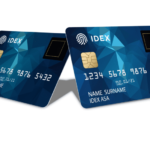The Next Step in FinTech
 The credit card is being reinvented, and plastic is going to make a comeback in the ongoing payments race. Thanks to the rise in mobile biometrics, FinTech has been an exciting space since the successful launch of Apple Pay in 2014. In fact, the most recent market research on the topic from Juniper predicts that by 2023 over $2 Trillion in mobile payments will be authorized by the use of biometric authentication. Smartphone and wearable based mobile wallets, conversational commerce, and even naked payments have not only captured the attention and support of consumers around the globe, but have done what many thought would be impossible five years ago – they’ve overshadowed the traditional credit card. And that’s no easy feat. Credit cards are ubiquitous and convenient, creating a high bar for competing payments solutions, but the biometric authentication on mobile wallets offered novelty in addition to stronger security and convenience than the average chip card. All of that’s changing however, because the biometric revolution has come to the credit card for the next step in FinTech, largely thanks to the efforts of IDEX.
The credit card is being reinvented, and plastic is going to make a comeback in the ongoing payments race. Thanks to the rise in mobile biometrics, FinTech has been an exciting space since the successful launch of Apple Pay in 2014. In fact, the most recent market research on the topic from Juniper predicts that by 2023 over $2 Trillion in mobile payments will be authorized by the use of biometric authentication. Smartphone and wearable based mobile wallets, conversational commerce, and even naked payments have not only captured the attention and support of consumers around the globe, but have done what many thought would be impossible five years ago – they’ve overshadowed the traditional credit card. And that’s no easy feat. Credit cards are ubiquitous and convenient, creating a high bar for competing payments solutions, but the biometric authentication on mobile wallets offered novelty in addition to stronger security and convenience than the average chip card. All of that’s changing however, because the biometric revolution has come to the credit card for the next step in FinTech, largely thanks to the efforts of IDEX.
IDEX, a fingerprint biometrics company based in Norway, is one of many sensor manufacturers focusing on the smart card market, which is widely seen as the next frontier in the commercial fingerprint space now that smartphones are achieving peak saturation. In 2018 the company made a strong pivot to the biometric cards market as its sole focus, and appointed a new CEO, Stan Swearingen, who used to be the company’s Chief Products Officer. The move was more than posturing in what was starting to look like a crowded and intense market – the year prior, IDEX had been at the forefront of innovation in the burgeoning biometric card market thanks in large part to its key technological innovations and its market-making partner, Mastercard. In a recent FindBiometrics interview, Swearingen even went so far as to tell me that IDEX no longer sees itself as a fingerprint biometrics company. “We see ourselves as a biometrics solutions provider,” he said.
“We really believe that in a new solution such as a biometric payment smart card, you need to have the whole solution and all the elements of the solution so that you can make the appropriate trades and solve the problems in the appropriate technology domains,” Swearingen continued.
Building it Better with Biometrics
 Like all payments solutions, the biometric payment card is a proposition of convenience and security, with an emphasis on the former when it comes to winning consumer adoption. From enrollment, to authentication, to the physical act of payment, users are prone to picking the path of least resistance, and so a new credit card ought to be at least as easy to activate and use as its previous generation and current competitors.
Like all payments solutions, the biometric payment card is a proposition of convenience and security, with an emphasis on the former when it comes to winning consumer adoption. From enrollment, to authentication, to the physical act of payment, users are prone to picking the path of least resistance, and so a new credit card ought to be at least as easy to activate and use as its previous generation and current competitors.
Where IDEX is concerned, insights gained through its multiple pilot projects in South Africa and the Middle East have allowed the company to adapt its card solutions to allow for a relatively friction-free experience. Chief among these insights, according to Swearingen, is the importance of the remote enrollment technology IDEX announced in late 2017, and which Mastercard officially adopted this past May.
“About a year ago, we highlighted self-enrollment as a potential enabler to mass deployment, because it just isn’t feasible to require customers to go into their local bank to enroll,” said Swearingen. “The old paradigm was that you would go into a branch, they would use an optical reader to capture your fingerprint, which would be stored in a central database and then be transferred onto the card. The paradigm we shifted to was one which we felt was feasible for security, convenience and for mass deployment. It comes within a low-cost plastic sleeve that can be shipped in the post, the whole process happens in an individual’s home and the fingerprint never leaves the card.”
In addition to the plastic sleeve, IDEX’s cards ship with a step-by-step enrollment guide inspired by the intuitive and highly visual smartphone fingerprint enrollment process. “What we saw was the need for something to guide the finger through that process,” said Swearingen. “We discovered that the quality of the enrollment really sets the foundation for the experience.”
In the authentication department, IDEX’s cards play it simple and elegant. As the CEO mentioned, the biometric data is stored and matched on the card, bringing a decentralized approach to data storage in line with the online authentication specs forwarded by the FIDO Alliance. Furthermore, the low cost bendable sensor draws its power from a payment terminal when it’s being used, in either inserted EMV chip or NFC tap configurations. That means no batteries, which means no upkeep. Beyond the actual fact that the card has a fingerprint sensor, the actual ownership of the card is the same as before.
Identity is the Limit
![]() Where things get different is the actual payments process. This is where consumer biometrics always shine brightest: in replacing the PIN with a fingerprint scan, biometric credit cards improve the user experience on all fronts. Adding a strong authentication factor to a tap-to-pay scenario means no more spending limits on the most convenient transaction method, and even when the chip must be inserted, a biometric card lets the user forgo the number pad entirely (tipping options not withstanding). IDEX’s cards are dual interface, meaning they work in either of the aforementioned scenarios. Once the next gen credit card is in a consumer’s wallet, it’s well positioned to be the only thing they pay with.
Where things get different is the actual payments process. This is where consumer biometrics always shine brightest: in replacing the PIN with a fingerprint scan, biometric credit cards improve the user experience on all fronts. Adding a strong authentication factor to a tap-to-pay scenario means no more spending limits on the most convenient transaction method, and even when the chip must be inserted, a biometric card lets the user forgo the number pad entirely (tipping options not withstanding). IDEX’s cards are dual interface, meaning they work in either of the aforementioned scenarios. Once the next gen credit card is in a consumer’s wallet, it’s well positioned to be the only thing they pay with.
New payments regulations are working in the solution’s favor, too. This September, when the PSD2 Strong Customer Authentication requirements come into play, biometrics are set to play a key role in compliance.
In the end the biometric card is just a better credit card, and that will work to its benefit. Mastercard can leverage its current distribution infrastructure to get IDEX’s tech in the hands of users everywhere. In our interview, Swearingen said that the company is prepared for rapid growth and we can “expect to see banks rolling out millions of biometric smart cards to millions of customers by 2019.” That means millions customers will be getting biometric payment cards through the mail, along with easy to understand instructions of how to activate them from home. In terms of biometric proliferation, it’s as good as it gets. And because smartphones and mobile wallets have already accustomed the general public with fingerprint scanning for payments, the transition will feel even more natural than if the next gen cards weren’t competing with the likes of Apple and Samsung.
This isn’t the end of the payments race, of course. But the biometric credit card is clearly the next step in an accelerated evolutionary payments ecosystem, setting a new bar for what the buying public will come to expect in terms of assurance, convenience, and security. And perhaps even more interesting is the fact that the next generation payment card proves the old FinTech mainstays are capable of innovation and trailblazing. Looking ahead, as the biometric powered arms race continues to benefit the consumer, the promise of what’s coming becomes tantalizing. Will it be an entirely new innovation or something familiar with an identity-focused twist? Only one thing is for sure, with biometrics redefining our very concept of seamless transactions, the only limit is our identity.
—
July 30, 2018 – by Peter B. Counter






![INTERVIEW: Fingerprint Cards SVP Thomas Rex Talks Biometric Cards at Money20/20 Europe [AUDIO]](https://idtechwire.com/wp-content/uploads/M2020EU18-FPC-Thomas-Rex-2-150x150.jpg)
Follow Us